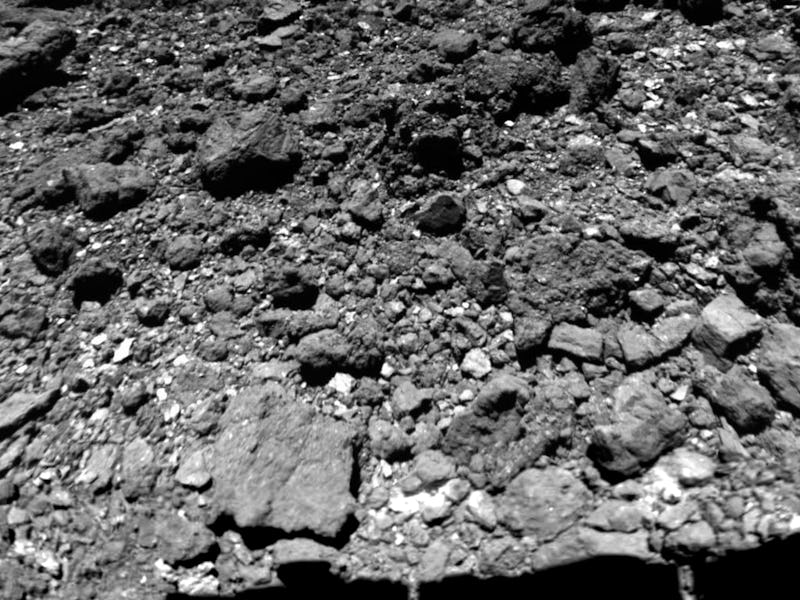Watch the moment Japan's spacecraft lands on asteroid Ryugu
The video reveals details of the asteroid's surface in great detail.

On May 10, 1999, a dark, rocky object that measures around 0.6 miles in diameter was discovered in the vast skies. The near-Earth, potentially hazardous asteroid was dubbed Ryugu, and is on an elliptical orbit around the Sun every 16 months, where it happens to cross the orbits of Earth and Mars.
In an effort to better understand these mysterious rocky bodies that fly by our planet, astronomers from the Japan Aerospace Exploration Agency (JAXA) sent a spacecraft to rendezvous with Ryugu. Now, you can watch it happen.
A recently released video reveals that rare encounter in mind-blowing detail, and gives us a rare glimpse at the surface of rocky asteroid.
The initial findings from the video were published Thursday in the journal Science.
Japan's asteroid-sampling spacecraft spent a long, five-year journey in space before landing on Ryugu on February 21, 2019. The video shows the moments where Hayabusa2 touches down on the asteroid, and collects a small sample of the rocky body to bring back to Earth.
These brief moments allowed astronomers to get a closer glimpse at the surface of Ryugu, and be able to get a better understanding of its age and geological history. It also helped scientists resolve a mystery regarding the color variations on the asteroid's surface.
Earlier observations by the spacecraft revealed that Ryugu's surface is made up of two different types of material that vary in color, with one being slightly red and the other being slightly blue. However, scientists were unable to predict what may have caused this strange color difference on the surface of the asteroid.
As Hayabusa2 lands on the asteroid, the onboard cameras captured the sampling process in great detail, revealing the disturbances to the surface that were caused by the spacecraft while it was collecting a sample from Ryugu.
Brief moments of the spacecraft's touchdown on the rocky asteroid.
The team of scientists observing the footage noticed how the thrusters on Hayabusa2 disturbed a coating of dark, fine-grained material that corresponded more with the reddish material on the surface of the asteroid.
Based on what the scientists know already of the different layers that make up Ryugu's craters, the new findings suggest that the reddish color may be a sort of suntan.
During Ryugu's orbit around the Sun, if the asteroid may at one point have turned a little bit towards the bright star for a brief period of time, then it may have caused intense solar heating that resulted in this red colored material on its surface.
The spacecraft had been collecting data on Ryugu for over a year before touching down on the asteroid.
JAXA launched the spacecraft Hayabusa2 on December 3, 2014. The spacecraft finally arrived at Ryugu in June, 2018. Afterwards, it spent more than a year orbiting its rocky companion, and collecting observations and images of Ryugu before its final touchdown.
The spacecraft is currently on its way home, bringing along samples from the asteroid to Earth for analysis. It is expected to land back on Earth in December, 2020.
This marks Japan's second asteroid sampling mission, with the pioneer Hayabusa mission returning samples from asteroid 25143 Itokawa to Earth on June 13, 2010.
Abstract: The near-Earth asteroid (162173) Ryugu is thought to be a primitive carbonaceous object that contains hydrated minerals and organic molecules. We report sample collection from Ryugu’s surface by the Hayabusa2 spacecraft on 21 February 2019. Touchdown images and global observations of surface colors are used to investigate the stratigraphy of the surface around the sample location and across Ryugu. Latitudinal color variations suggest the reddening of exposed surface material by solar heating and/or space weathering. Immediately after touchdown, Hayabusa2’s thrusters disturbed dark, fine grains that originate from the redder materials. The stratigraphic relationship between identified craters and the redder material indicates that surface reddening occurred over a short period of time. We suggest that Ryugu previously experienced an orbital excursion near the Sun.